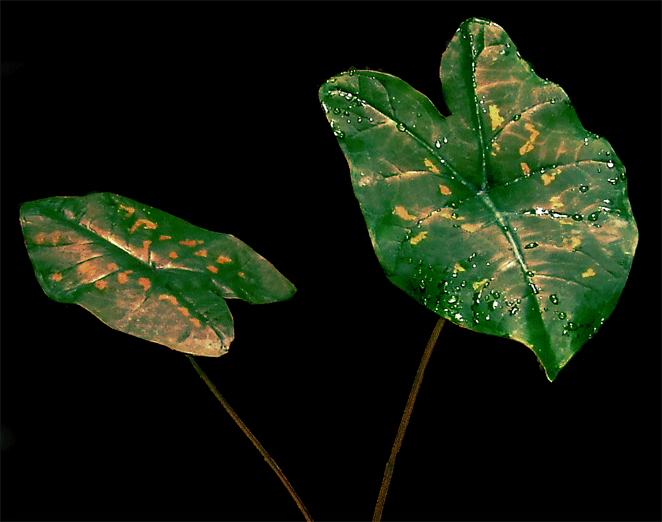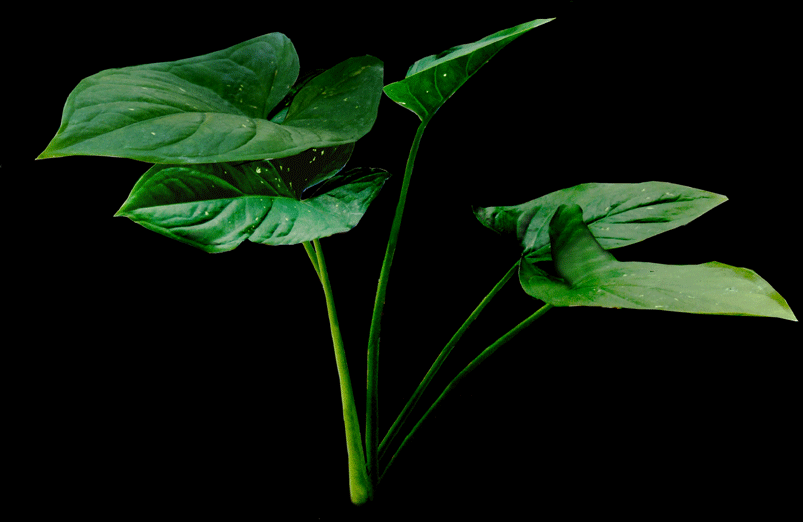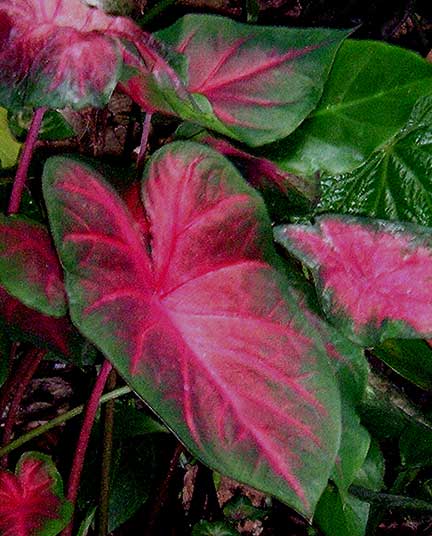![]()
Aroids and other genera in the Collection
Take the Tour Now?
Orchids
The
Exotic Rainforest
Plants in
the Exotic Rainforest Collection
Images on this website are copyright protected. Contact us before
attempting to reuse.
Caladium bicolor
(Aiton) Vent.
One of the most variable of all aroid species!
One of the most variable of all aroid species!

Caladium bicolor (Aiton) Vent.
Synonyms:
Arum vermitoxicum,
Caladium adamantinum,
Caladium argyrospilum,
Caladium barraquinii, Caladium belleyenei, Caladium brongniartii, Caladium chantinii,
Caladium concolor, Caladium devosianum, Caladium enkeanum, Caladium fermulum,
Caladium haematostigma, Caladium hastatum, Caladium hortulanum, Caladium houlletii,
Caladium laucheanum, Caladium lemaireanum, Caladium macrophyllum, Caladium marginatum,
Caladium marmoratum, Caladium medio-radiatum, Caladium mirabile, Caladium neumanni,
Caladium pallidum, Caladium perrieri, Caladium picturatum, Caladium poecile, Caladium porphyroneuron,
Caladium purdieanum, Caladium regale, Caladium sagittatum, Caladium smaragdinum, Caladium sororium,
Caladium spruceanum, Caladium stangeanum, Caladium steudneriaefolium, Caladium surinamense,
Caladium troubetzkoyi, Caladium vellozianum, Caladium verschaffeltii, Caladium x hortulanum
Variations: Caladium bicolor var. albomaculatum, Caladium bicolor var. argyrospilum,
Caladium bicolor var. barraquinii, Caladium bicolor var. bohemicum, Caladium bicolor var. brongniartii,
Caladium bicolor var. chantinii, Caladium bicolor var. curwadlii, Caladium bicolor var. devosianum,
Caladium bicolor subvar. donizettii, Caladium bicolor var. duchartrei, Caladium bicolor var. enkeanum,
Caladium bicolor var. hendersonii, Caladium bicolor var. houbyanym, Caladium bicolor var. houlletii,
Caladium bicolor var. ketteleri, Caladium bicolor var. kochii, Caladium bicolor var. kramerianum,
Caladium bicolor var. laucheanum, Caladium bicolor var. leopoldii, Caladium bicolor var. lindenii,
Caladium bicolor var. macrophyllum, Caladium bicolor var. marginatum, Caladium bicolor var. mirabile,
Caladium bicolor var. neumannii, Caladium bicolor var. pellucidum, Caladium bicolor var. perrieri,
Caladium bicolor var. pictum, Caladium bicolor var. regale, Caladium bicolor subvar. rosaceum,
Caladium bicolor var. roseo-maculatum, Caladium bicolor var. rubellum, Caladium bicolor var. rubicundum,
Caladium bicolor var. rubrivenium, Caladium bicolor var. sieboldii, Caladium bicolor var. splendens,
Caladium bicolor var. stangeanum, Caladium bicolor var. surinamense, Caladium bicolor var. transparens,
Caladium bicolor var. vermitoxicum, Caladium bicolor var. verschaffeltii, Caladium bicolor var. wightii
Caladium barraquinii, Caladium belleyenei, Caladium brongniartii, Caladium chantinii,
Caladium concolor, Caladium devosianum, Caladium enkeanum, Caladium fermulum,
Caladium haematostigma, Caladium hastatum, Caladium hortulanum, Caladium houlletii,
Caladium laucheanum, Caladium lemaireanum, Caladium macrophyllum, Caladium marginatum,
Caladium marmoratum, Caladium medio-radiatum, Caladium mirabile, Caladium neumanni,
Caladium pallidum, Caladium perrieri, Caladium picturatum, Caladium poecile, Caladium porphyroneuron,
Caladium purdieanum, Caladium regale, Caladium sagittatum, Caladium smaragdinum, Caladium sororium,
Caladium spruceanum, Caladium stangeanum, Caladium steudneriaefolium, Caladium surinamense,
Caladium troubetzkoyi, Caladium vellozianum, Caladium verschaffeltii, Caladium x hortulanum
Variations: Caladium bicolor var. albomaculatum, Caladium bicolor var. argyrospilum,
Caladium bicolor var. barraquinii, Caladium bicolor var. bohemicum, Caladium bicolor var. brongniartii,
Caladium bicolor var. chantinii, Caladium bicolor var. curwadlii, Caladium bicolor var. devosianum,
Caladium bicolor subvar. donizettii, Caladium bicolor var. duchartrei, Caladium bicolor var. enkeanum,
Caladium bicolor var. hendersonii, Caladium bicolor var. houbyanym, Caladium bicolor var. houlletii,
Caladium bicolor var. ketteleri, Caladium bicolor var. kochii, Caladium bicolor var. kramerianum,
Caladium bicolor var. laucheanum, Caladium bicolor var. leopoldii, Caladium bicolor var. lindenii,
Caladium bicolor var. macrophyllum, Caladium bicolor var. marginatum, Caladium bicolor var. mirabile,
Caladium bicolor var. neumannii, Caladium bicolor var. pellucidum, Caladium bicolor var. perrieri,
Caladium bicolor var. pictum, Caladium bicolor var. regale, Caladium bicolor subvar. rosaceum,
Caladium bicolor var. roseo-maculatum, Caladium bicolor var. rubellum, Caladium bicolor var. rubicundum,
Caladium bicolor var. rubrivenium, Caladium bicolor var. sieboldii, Caladium bicolor var. splendens,
Caladium bicolor var. stangeanum, Caladium bicolor var. surinamense, Caladium bicolor var. transparens,
Caladium bicolor var. vermitoxicum, Caladium bicolor var. verschaffeltii, Caladium bicolor var. wightii
Both specimens shown were collected in Trinidad
and are
natural variations of Caladium bicolor. The first is known as
"Pigeon's Blood".
Caladium bicolor is an aroid that grow from a tuber often
incorrectly called a "bulb". A tropical perennial, Caladium sp.
have no stems but rather grow their showy matte leaf blades on long petioles
that rise directly from the tuber. The tuber is a subterranean round
to elongated fleshy rhizome which serves as a storage organ. The petioles typically measure 15 to
30cm (6 to 12 inches). The leaf veins are distinctly seen beneath the leaf
blade.
The
petioles are terete (round) and are attached to the leaves at or near the
center of the blade rather than at the end. The majority of hybridized
Caladium plants bought at nurseries are hybrid forms of Caladium
bicolor and not true species. The leaves of Caladium bicolor
have a large variety of shapes, sizes, and color variations. At least one
thousand named Caladium cultivars exist, mostly with lance or heart
shaped leaves. Only two natural variations are
 shown on this page,
both were wild collected on the island of Trinidad and are not necessarily
typical of all forms of
Caladium bicolor.
shown on this page,
both were wild collected on the island of Trinidad and are not necessarily
typical of all forms of
Caladium bicolor.
 shown on this page,
both were wild collected on the island of Trinidad and are not necessarily
typical of all forms of
Caladium bicolor.
shown on this page,
both were wild collected on the island of Trinidad and are not necessarily
typical of all forms of
Caladium bicolor.
An old world species,
Caladium bicolor has been collected in Bolivia, Brazil, Cameroon,
Puerto Rico, Tobago, Trinidad, the Windward Islands, Colombia, Costa Rica,
Ecuador, El Salvador, French Guiana, Gabon, Guyana, Honduras, Mexico,
Nicaragua, Panama, Paraguay, Peru, Sierra Leon, Suriname, Venezuela and
other locations. As is obvious from the large number of synonym names (same
species, other scientific name) seen at the top of this page, Caladium
bicolor is a highly variable aroid species. It is quite common to find
natural specimens that vary greatly in blade shape, pattern and color.
The specimen shown at the top of
the page is being called "Pigeon's Blood". Aroid expert and collector
Julius Boos explains,
"The "Pigeon`s blood",
is is a variety of Caladium bicolor. I gave it that name (which is NOT a
registered cultivar name, so I guess it could be considered just a name I
gave it to distinguish it from all the other color forms/vars. of C. bicolor
which you can find on that same road in the Northern Range of Trinidad, W.I.).
I collected it growing on the side of a wet road-side drain along
Blanchisseuse Road which runs north out of the town of Arima, and winds and
curves over the Northern Range of hills then down to the North Coast. I
would guess the elevation was about 1,800 ft.. When I saw it growing, the
red spots struck me as being very attractive. In the gloom of the day they
looked like spots of pigeon`s bloom that might have dripped on to the dark
green leaf blade from a shot bird."
The photo to the left (below) is a hybrid Caladium variation commonly sold as a landscape plant but originated with Caladium bicolor.
The photo to the left (below) is a hybrid Caladium variation commonly sold as a landscape plant but originated with Caladium bicolor.
 The
second specimen above was also collected by Julius, "this
is just another of the many color variations of Caladium bicolor found in
abundance in certain areas throughout Trinidad. There are also many more
plants of this species with all-green leaf blades, some with just a
red-brown spot in the center of the leaf blade. All are wonderful plants,
and give any naturalist or aroid collector reason to pause and just wonder
at one of the many natural marvels one can encounter on a walk along most
roads or trails in the wooded areas of Trinidad and Tobago, West Indies."
The
second specimen above was also collected by Julius, "this
is just another of the many color variations of Caladium bicolor found in
abundance in certain areas throughout Trinidad. There are also many more
plants of this species with all-green leaf blades, some with just a
red-brown spot in the center of the leaf blade. All are wonderful plants,
and give any naturalist or aroid collector reason to pause and just wonder
at one of the many natural marvels one can encounter on a walk along most
roads or trails in the wooded areas of Trinidad and Tobago, West Indies."All Caladium species are aroids. An aroid is a plant that reproduces by producing an inflorescence known as a spathe and spadix. Most people believe the spathe is a "flower", it is not. The spathe is simply a specially modified leaf with a spadix growing at its center. The spathe is normally close to 23cm (9 inches) long with a greenish white spadix and spathe and is somewhat similar to the spathe of a Jack-in-the-Pulpit. On the spadix there can be found very tiny flowers when the plant is at anthesis and prepared to be pollinated. When ready, the spadix produces both male, female and sterile flowers which if pollinated will produce berries containing seeds. Small white berries eventually develop on the spadix
Caladium species and hybrids prefer damp shaded conditions and few if any will tolerate direct sunlight.
Natural variation
within aroid species is common. Not every leaf of every specimen will
always appear the same. This link explains in non-technical
language natural variation and morphogenesis within aroid and other plant
species:
Click
here.
Join the
International Aroid Society:
http://www.exoticrainforest.com/Join%20IAS.html
Aroid Pollination!
As it occurs in nature and
by any horticulturist